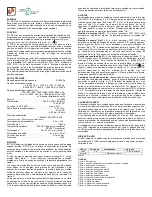
Installation
DIQ/S 281
14
ba77244d01
08/2020
DIQ modules are installed must be connected to the local potential equaliza-
tion system and the grounding system or must be individually sufficiently
grounded locally according to the codes of practice.
For the individual grounding of the measuring point the mounting construc-
tion must be solidly connected by means of a large-area auxiliary electrode
with the measuring medium.
Metallic control shafts/pipes and other large-area metallic bodies that reach
into the measuring medium are, for example, ideal for use in the grounding
of the mounting construction. This creates a set path for the main surge. As
a result it is possible to avoid the surge being discharged via the cable and
via the valuable sensor in the measuring medium.
4 It is recommended to attach a metallic or nonmetallic sun shield to each out-
side location of the DIQ modules. Sun shields protect the electric field lines
in the area of the DIQ module due to an advantageous development of the
electrical field lines in the area of the MIQ module and promote the dissipa-
tion of the surge via the mounting construction.
5 The line voltage for the supply of the DIQ/S 28X must comply with overvolt-
age category II. Generally this is ensured through the public operator of the
power supply networks. In company-owned networks, e.g. in all power supply
systems owned by wastewater treatment plants, this must be kept separate
by a potential equalization and a surge protection system for the plant.
6 One part of the safety and lightning protection concept is based on the high-
grade protective insulation of the DIQ/S 28X. It does not have or require any
protective ground conductor or earth terminal. Avoid any direct contact of any
SENSOR connections or the metallic sensor enclosures with the local
grounding or potential equalization system and with metallic construction el-
ements (see point 8).
7 Additional external lightning protection measures, e.g. the use of overvoltage
surge arresters, are not necessary for protection against the indirect effects
of lightning and could possibly result in malfunctions.
8 For the realization of the internal lightning protection of the system (e.g.
wastewater treatment plant control stands) and for the protection of external
resources, cable entry points into buildings or distributions coming from the
DIQ/S 28X must be carried out as follows:
– The shield of SNCIQ or SNCIQ-UG cables can be connected to the local
potential equalization with a gas overvoltage arrester. Use shield clamps
for the contacting of the shield. The shield of the cable must not be opened
under any circumstances.
– 0/4-20 mA interfaces must be realized with shielded cables. The cable
shield must be connected directly to the potential equalization(s) provided.
If plant potential equalization systems are provided on both sides, the
shield must also be connected on both sides. The inner conductors must
have no contact with the potential equalization.
– Relay lines should be connected to the local potential equalization in order
to provide general and consistent protection via gas overvoltage surge
arresters.















































